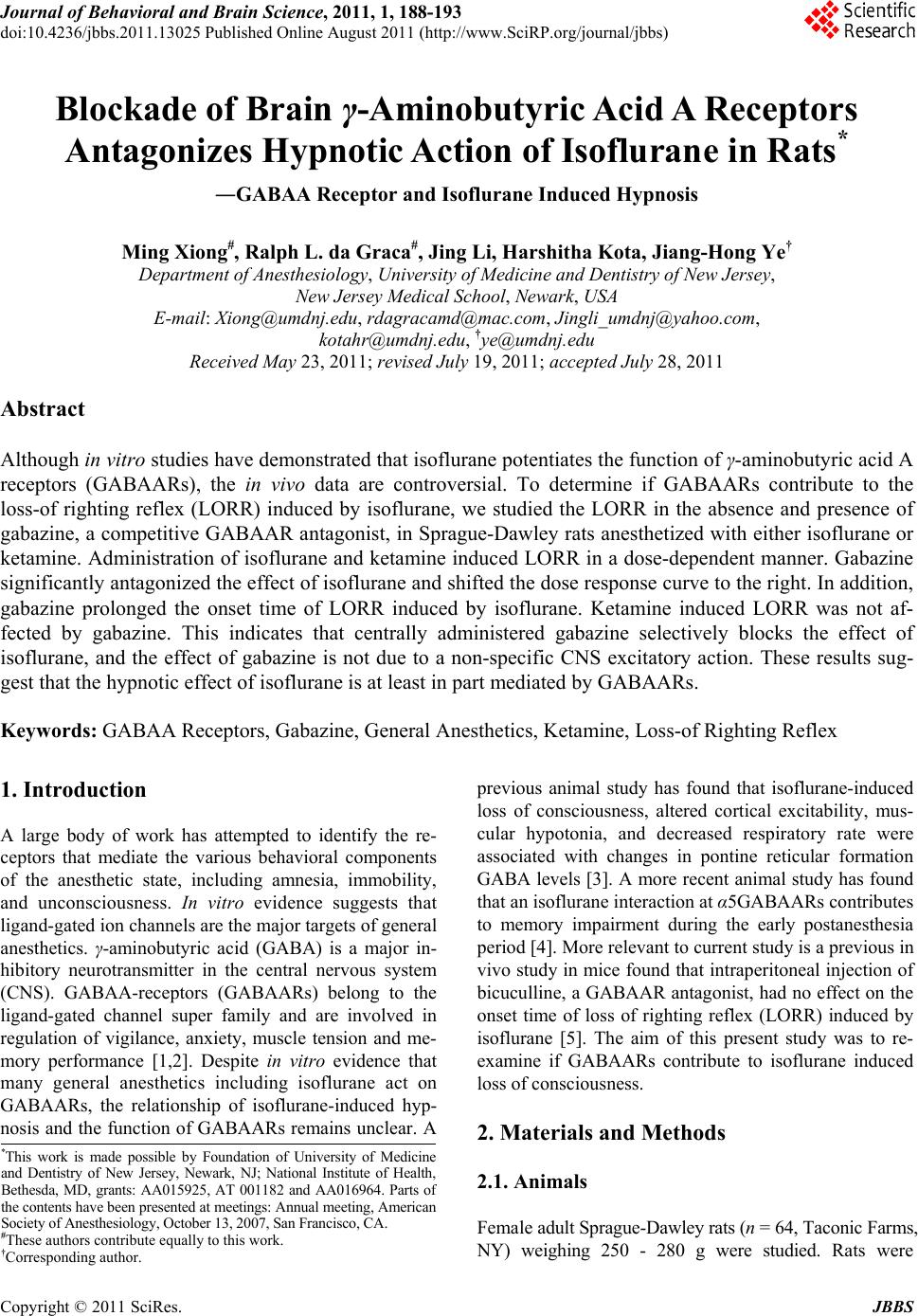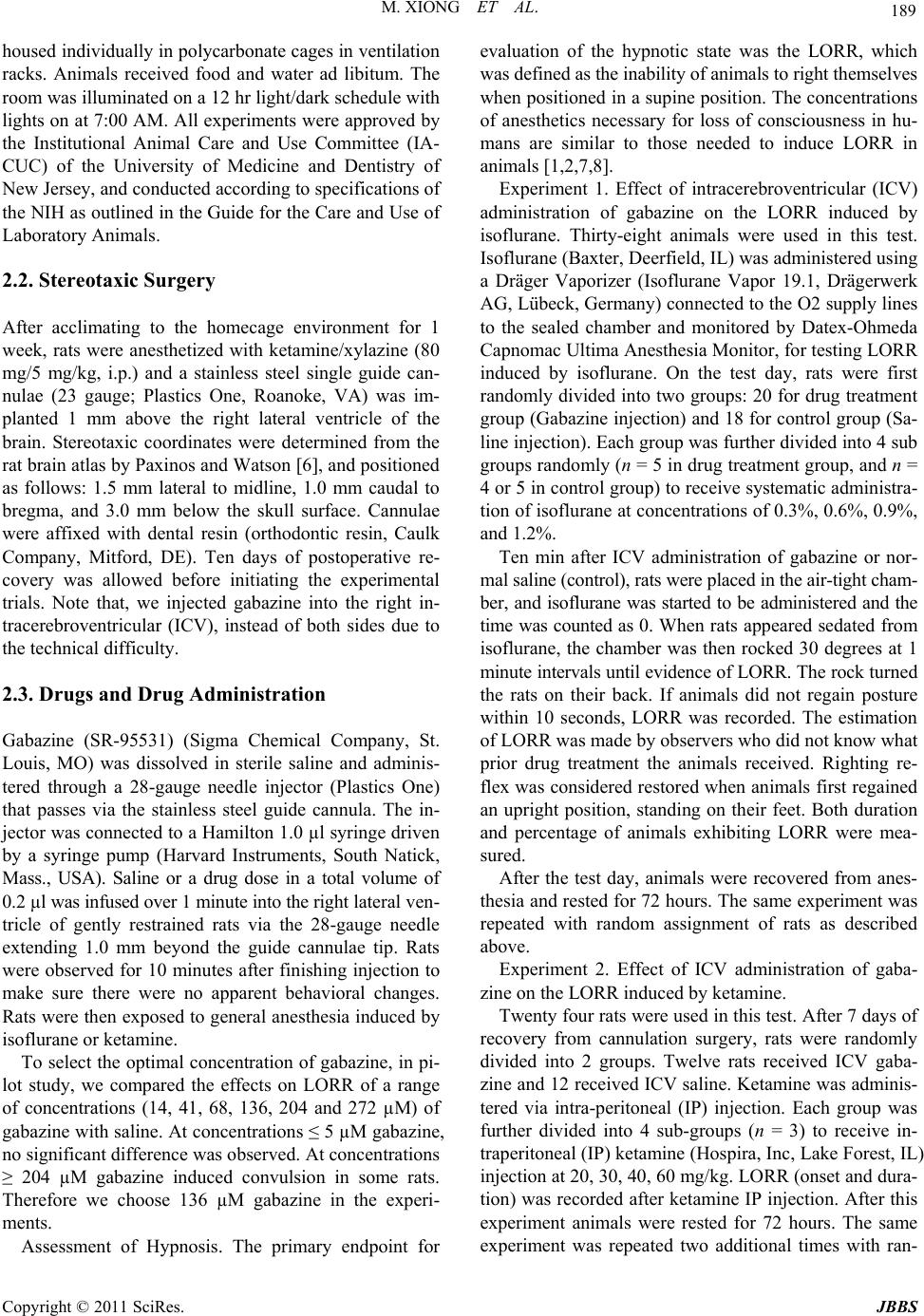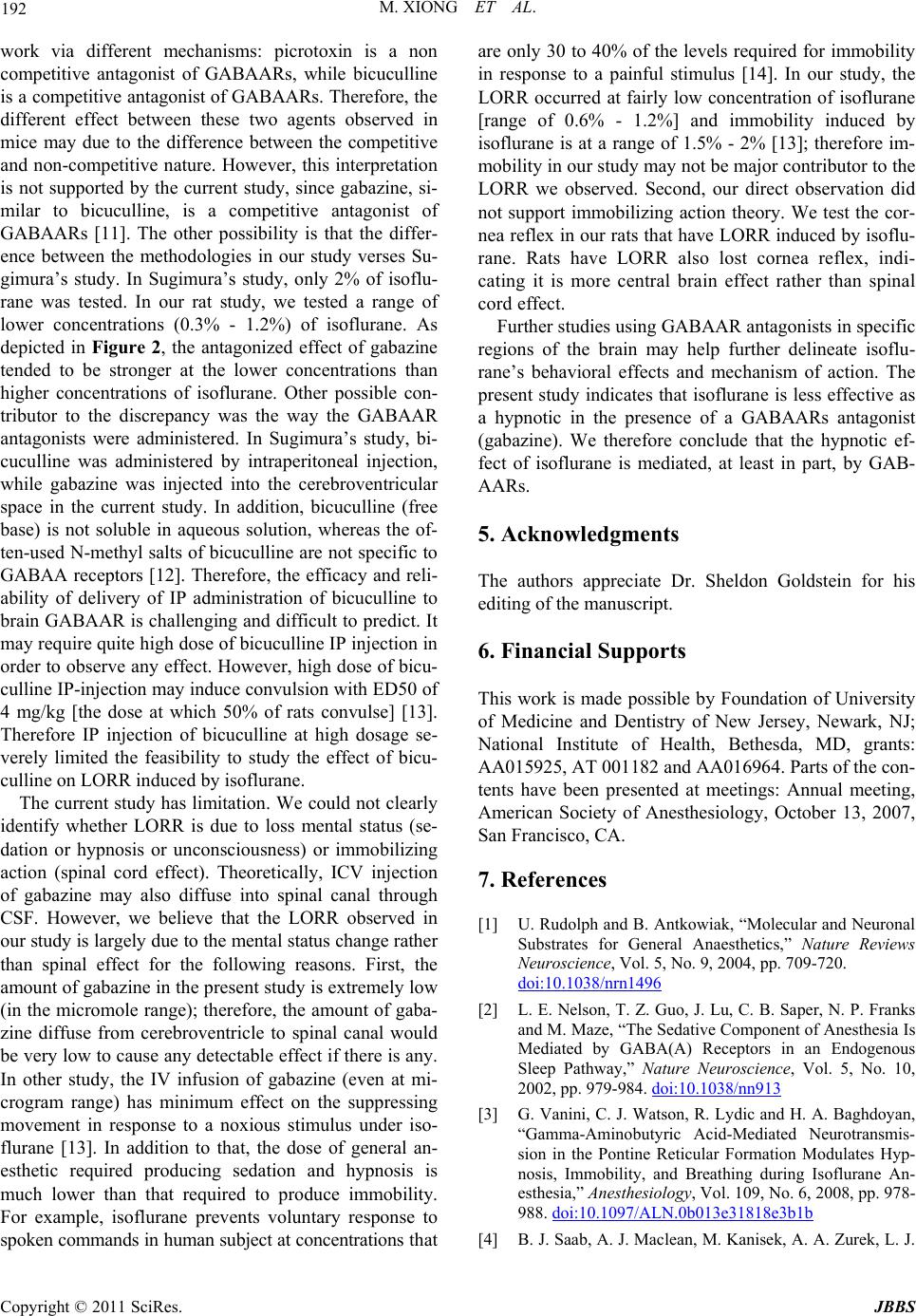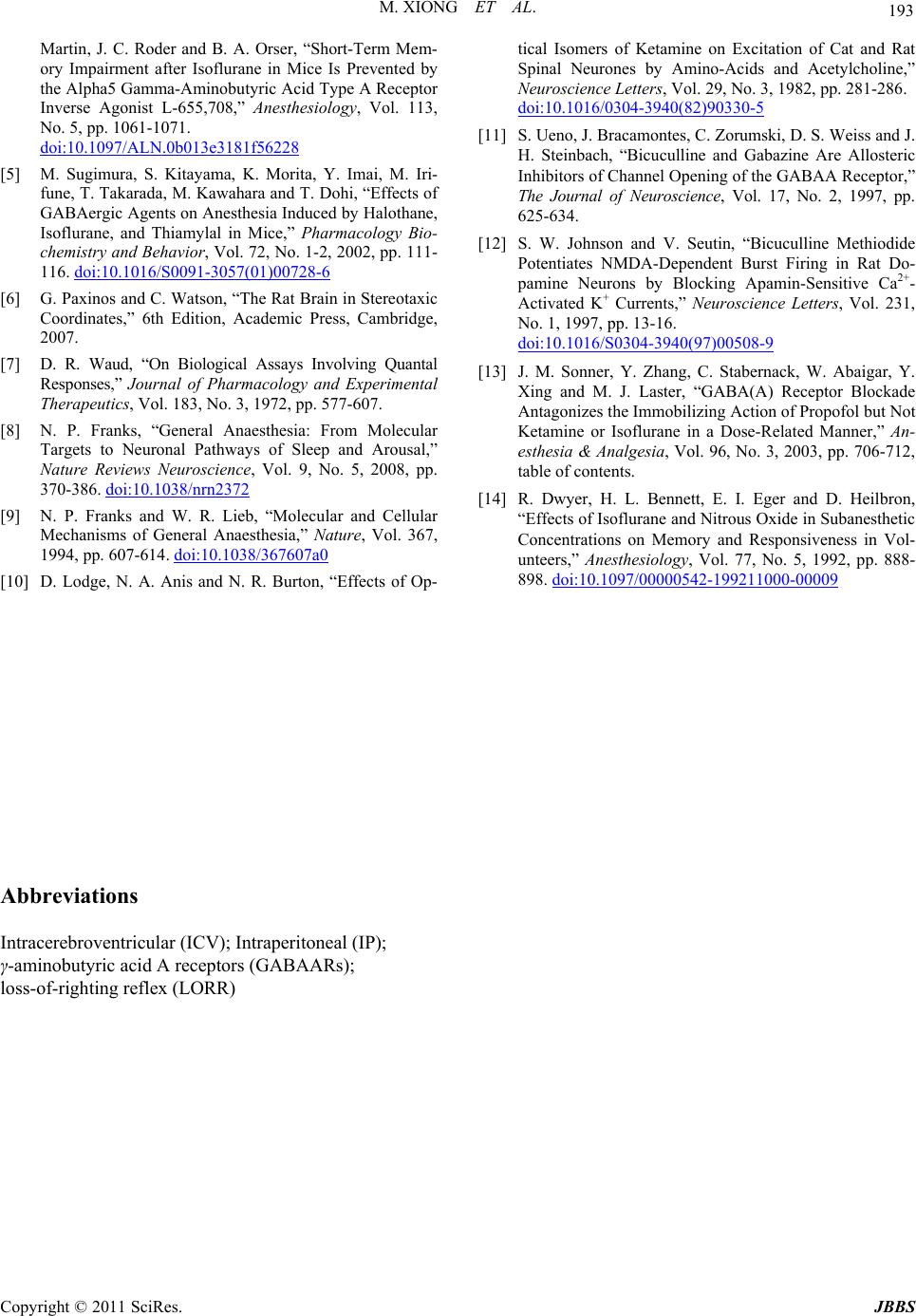Paper Menu >>
Journal Menu >>
 Journal of Behavioral and Brain Science, 2011, 1, 188-193 doi:10.4236/jbbs.2011.13025 Published Online August 2011 (http://www.SciRP.org/journal/jbbs) Copyright © 2011 SciRes. JBBS Blockade of Brain γ-Aminobutyric Acid A Receptors Antagonizes Hypnotic Action of Isoflurane in Rats* ―GABAA Receptor and Isoflurane Induced Hypnosis Ming Xiong#, Ralph L. da Graca#, Jing Li, Harshitha Kota, Jiang-Hong Ye† Department of Anesthesiology, University of Medicine and Dentistry of New Jersey, New Jersey Medical School, Newark, USA E-mail: Xiong@umdnj.edu, rdagracamd@mac.com, Jingli_umdnj@yahoo.com, kotahr@umdnj.edu, †ye@umdnj.edu Received May 23, 2011; revised July 19, 2011; accepted July 28, 2011 Abstract Although in vitro studies have demonstrated that isoflurane potentiates the function of γ-aminobutyric acid A receptors (GABAARs), the in vivo data are controversial. To determine if GABAARs contribute to the loss-of righting reflex (LORR) induced by isoflurane, we studied the LORR in the absence and presence of gabazine, a competitive GABAAR antagonist, in Sprague-Dawley rats anesthetized with either isoflurane or ketamine. Administration of isoflurane and ketamine induced LORR in a dose-dependent manner. Gabazine significantly antagonized the effect of isoflurane and shifted the dose response curve to the right. In addition, gabazine prolonged the onset time of LORR induced by isoflurane. Ketamine induced LORR was not af- fected by gabazine. This indicates that centrally administered gabazine selectively blocks the effect of isoflurane, and the effect of gabazine is not due to a non-specific CNS excitatory action. These results sug- gest that the hypnotic effect of isoflurane is at least in part mediated by GABAARs. Keywords: GABAA Receptors, Gabazine, General Anesthetics, Ketamine, Loss-of Righting Reflex 1. Introduction A large body of work has attempted to identify the re- ceptors that mediate the various behavioral components of the anesthetic state, including amnesia, immobility, and unconsciousness. In vitro evidence suggests that ligand-gated ion channels are the major targets of general anesthetics. γ-aminobutyric acid (GABA) is a major in- hibitory neurotransmitter in the central nervous system (CNS). GABAA-receptors (GABAARs) belong to the ligand-gated channel super family and are involved in regulation of vigilance, anxiety, muscle tension and me- mory performance [1,2]. Despite in vitro evidence that many general anesthetics including isoflurane act on GABAARs, the relationship of isoflurane-induced hyp- nosis and the function of GABAARs remains unclear. A previous animal study has found that isoflurane-induced loss of consciousness, altered cortical excitability, mus- cular hypotonia, and decreased respiratory rate were associated with changes in pontine reticular formation GABA levels [3]. A more recent animal study has found that an isoflurane interaction at α5GABAARs contributes to memory impairment during the early postanesthesia period [4]. More relevant to current study is a previous in vivo study in mice found that intraperitoneal injection of bicuculline, a GABAAR antagonist, had no effect on the onset time of loss of righting reflex (LORR) induced by isoflurane [5]. The aim of this present study was to re- examine if GABAARs contribute to isoflurane induced loss of consciousness. 2. Materials and Methods 2.1. Animals Female adult Sprague-Dawley rats (n = 64, Taconic Farms, NY) weighing 250 - 280 g were studied. Rats were *This work is made possible by Foundation of University of Medicine and Dentistry of New Jersey, Newark, NJ; National Institute of Health, Bethesda, MD, grants: AA015925, AT 001182 and AA016964. Parts o f the contents have been presented at meetings: Annual meeting, American Society of Anesthesiology, October 13, 2007, San Francisco, CA. #These authors contribute equally to this work. †Corresponding author.  M. XIONG ET AL. Copyright © 2011 SciRes. JBBS 189 housed individually in polycarbonate cages in ventilation racks. Animals received food and water ad libitum. The room was illuminated on a 12 hr light/dark schedule with lights on at 7:00 AM. All experiments were approved by the Institutional Animal Care and Use Committee (IA- CUC) of the University of Medicine and Dentistry of New Jersey, and conducted according to specifications of the NIH as outlined in the Guide for the Care and Use of Laboratory Animals. 2.2. Stereotaxic Surgery After acclimating to the homecage environment for 1 week, rats were anesthetized with ketamine/xylazine (80 mg/5 mg/kg, i.p.) and a stainless steel single guide can- nulae (23 gauge; Plastics One, Roanoke, VA) was im- planted 1 mm above the right lateral ventricle of the brain. Stereotaxic coordinates were determined from the rat brain atlas by Paxinos and Watson [6], and positioned as follows: 1.5 mm lateral to midline, 1.0 mm caudal to bregma, and 3.0 mm below the skull surface. Cannulae were affixed with dental resin (orthodontic resin, Caulk Company, Mitford, DE). Ten days of postoperative re- covery was allowed before initiating the experimental trials. Note that, we injected gabazine into the right in- tracerebroventricular (ICV), instead of both sides due to the technical difficulty. 2.3. Drugs and Drug Administration Gabazine (SR-95531) (Sigma Chemical Company, St. Louis, MO) was dissolved in sterile saline and adminis- tered through a 28-gauge needle injector (Plastics One) that passes via the stainless steel guide cannula. The in- jector was connected to a Hamilton 1.0 µl syringe driven by a syringe pump (Harvard Instruments, South Natick, Mass., USA). Saline or a drug dose in a total volume of 0.2 µl was infused over 1 minute into the right lateral ven- tricle of gently restrained rats via the 28-gauge needle extending 1.0 mm beyond the guide cannulae tip. Rats were observed for 10 minutes after finishing injection to make sure there were no apparent behavioral changes. Rats were then exposed to general anesthesia induced by isoflurane or ketamine. To select the optimal concentration of gabazine, in pi- lot study, we compared the effects on LORR of a range of concentrations (14, 41, 68, 136, 204 and 272 µM) of gabazine with saline. At concentrations ≤ 5 µM gabazine, no significant difference was observed. At concentrations ≥ 204 µM gabazine induced convulsion in some rats. Therefore we choose 136 µM gabazine in the experi- ments. Assessment of Hypnosis. The primary endpoint for evaluation of the hypnotic state was the LORR, which was defined as the inability of animals to right themselves when positioned in a supine position. The concentrations of anesthetics necessary for loss of consciousness in hu- mans are similar to those needed to induce LORR in animals [1,2,7,8]. Experiment 1. Effect of intracerebroventricular (ICV) administration of gabazine on the LORR induced by isoflurane. Thirty-eight animals were used in this test. Isoflurane (Baxter, Deerfield, IL) was administered using a Dräger Vaporizer (Isoflurane Vapor 19.1, Drägerwerk AG, Lübeck, Germany) connected to the O2 supply lines to the sealed chamber and monitored by Datex-Ohmeda Capnomac Ultima Anesthesia Monitor, for testing LORR induced by isoflurane. On the test day, rats were first randomly divided into two groups: 20 for drug treatment group (Gabazine injection) and 18 for control group (Sa- line injection). Each group was further divided into 4 sub groups randomly (n = 5 in drug treatment group, and n = 4 or 5 in control group) to receive systematic administra- tion of isoflurane at concentrations of 0.3%, 0.6%, 0.9%, and 1.2%. Ten min after ICV administration of gabazine or nor- mal saline (control), rats were placed in the air-tight cham- ber, and isoflurane was started to be administered and the time was counted as 0. When rats appeared sedated from isoflurane, the chamber was then rocked 30 degrees at 1 minute intervals until evidence of LORR. The rock turned the rats on their back. If animals did not regain posture within 10 seconds, LORR was recorded. The estimation of LORR was made by observers who did not know what prior drug treatment the animals received. Righting re- flex was considered restored when animals first regained an upright position, standing on their feet. Both duration and percentage of animals exhibiting LORR were mea- sured. After the test day, animals were recovered from anes- thesia and rested for 72 hours. The same experiment was repeated with random assignment of rats as described above. Experiment 2. Effect of ICV administration of gaba- zine on the LORR induced by ketamine. Twenty four rats were used in this test. After 7 days of recovery from cannulation surgery, rats were randomly divided into 2 groups. Twelve rats received ICV gaba- zine and 12 received ICV saline. Ketamine was adminis- tered via intra-peritoneal (IP) injection. Each group was further divided into 4 sub-groups (n = 3) to receive in- traperitoneal (IP) ketamine (Hospira, Inc, Lake Forest, IL) injection at 20, 30, 40, 60 mg/kg. LORR (onset and dura- tion) was recorded after ketamine IP injection. After this experiment animals were rested for 72 hours. The same experiment was repeated two additional times with ran-  M. XIONG ET AL. Copyright © 2011 SciRes. JBBS 190 dom assignment to groups. Histological verification of cannulae placements. After completion of the experimental procedures, rats were overdosed with pentobarbital and decapitated. Brains were carefully removed and fixed in 4% paraformaldehyde for 4 hours. Coronal brain slices (40 µm) across the cannula- tion site were prepared using a Zeiss Microm HM 550 Cryostat to confirm cannulae tip in the right ventricule under microscopy. Animals with cannulae tip located outside the ventricle were indentified and excluded from data analysis. Statistical Analysis. Values are expressed as mean ± S.E.M. Data were analyzed using paired t test. Data in- volving multiple comparisons were analyzed with two- way ANOVA. Values of p < 0.05 were considered sig- nificant. Dose-response data were fitted as previously described [2,7] to a logistic equation of the form: P = 100Dn/(Dn + (ED50)n) where P is the percent of the po- pulation anesthetized, D is the drug dose, n is the slope parameter, and ED50 is the drug dose for a half-maximal effect. 3. Results 3.1. Isoflurane Concentrations in the Sealed Chamber First we tested the reliability of peak and steady state concentrations of isoflurane in the sealed chamber. As indicated in Figure 1, the administration of isoflurane rapidly increased the concentration of isoflurane in the chamber and reached the plateau. The time required to reach the plateau decreased with increasing concentrations of isoflurane. The average time to peak (desired concen- tration) was approximately 2 minutes, which followed with a steady state that remained stable for more than 10 minutes (Figure 1). At 10 min, the test was terminated by evacuating the isoflurane with a vacuum. 3.2. Gabazine Attenuates the LORR Induced by Isoflurane Next, we tested the effects of ICV administration of ga- bazine on the hypnotic effect of isoflurane. The LORR was used as the primary measure for isoflurane-induced hypnosis because it has been reported that the concentra- tions necessary to produce the hypnotic state in humans are similar to those needed to induce LORR in animals [1,2,8]. Seven (out of 38) rats in this experiment showed cannulae placements outside the right lateral ventricle. These animals were excluded from the data analysis. As indicated in Figure 2, in rats who received ICV sa- line, isoflurane induced LORR in a dose-dependent Figure 1. The time to peak of isoflurane decreases with in- creasing isoflurane. Average time to peak was ~2 minutes, with steady state maintained >10 minutes before vacuum was applied. fashion. In rats who received ICV gabazine, a significant reduction in the percent of rats exhibiting LORR was observed at both 0.6% and 0.9% isoflurane. This effect resulted in both a significant rightward shift of the dose response curve and an increased IC50 value of isoflurane (from 0.59% ± 0.04% in saline to 0.78% ± 0.03% in gabazine) (Figure 2(a)). In addition, in rats who received ICV gabazine and displayed LORR, a significant delay of onset time of LORR was observed at 0.6% isoflurane (p = 0.011) and 0.9 % isoflurane (p = 0.049) compared with rats who received ICV saline (Figure 2(b)). 3.3. Gabazine Does Not Affect the LORR Induced by Intraperitoneal (IP) Ketamine Ketamine induces hypnosis via inhibition of NMDA subtype glutamate receptors in the brain [10]. To confirm that gabazine reduction of isoflurane-induced LORR is not due to a non-specific central nervous system (CNS) excitatory action, we tested the effects of gabazine on the hypnotic effect of ketamine in 24 rats. Two animals were excluded from the data analysis due to histological evi- dence documenting that cannulae were placed outside the right lateral ventricle. Similar to isoflurane, IP ketamine produced LORR in a dose-dependent fashion. However, in contrast to isoflu- rane, ICV administration of gabazine did not affect the LORR (neither the percentage nor the duration or onset time) induced by any dose of ketamine (Figure 3). These  M. XIONG ET AL. Copyright © 2011 SciRes. JBBS 191 Figure 2. Systematic administration of isoflurane dose- dependently induced LORR. (a) ICV administration of gabazine (136 µM) produced a large reduction in the % LORR induced by isoflurane, a significant rightward shift of the dose response curve of isoflurane, and a significant increase in the IC50 values of isoflurane (from 0.59% ± 0.04% to 0.78% ± 0.03%). Each point is the mean of the results from tests on 10 - 14 rats; (b) Gabazine prolonged the onset time of LORR. In those rats administered with gabazine and evidence of LORR, significant prolongation of onset time of LORR was observed at 0.6% and 0.9% isoflurane. The values are expressed as mean ± S.E.M. Number of rats in each group is indicated. *p < 0.05, ***p < 0.001 compared with saline groups (Paired t test). results suggest that centrally administered gabazine se- lectively blocks the effect of isoflurane, and the effect of gabazine is not due to a non-specific CNS excitatory action. 4. Discussion Our study demonstrates that gabazine antagonized the Figure 3. ICV administration of gabazine (136 µM) did not affect the LORR induced by ketamine. Intraperitoneal in- jection of ketamine dose-dependently induced LORR. (a) ICV administration of gabazine (136 µM) did not affect the percentage of LORR compared to ICV administration of saline. (b) Onset time for LORR animals are not affected by ICV gabazine injection. The values are expressed as mean ± S.E.M. Number of rats in each group is indicated. LORR induced by isoflurane, as evidenced by reducing the percentage of rats exhibiting isoflurane-induced LORR and by increasing the onset time in those animals at 0.6% and 0.9% isoflurane. In a previous study, Sugimura and colleagues reported that bicuculline had no effect on the onset time of isoflu- rane-induced LORR in mice [5]. While the mechanisms underlying the discrepancy between the present study and theirs required further study, there are several possi- ble interpretations. In Sugimura’s study, they found that picrotoxin can prolong the onset time of LORR induced by isoflurane which is different from the effect of bicu- culline. It is known that these two GABAAR antagonists  M. XIONG ET AL. Copyright © 2011 SciRes. JBBS 192 work via different mechanisms: picrotoxin is a non competitive antagonist of GABAARs, while bicuculline is a competitive antagonist of GABAARs. Therefore, the different effect between these two agents observed in mice may due to the difference between the competitive and non-competitive nature. However, this interpretation is not supported by the current study, since gabazine, si- milar to bicuculline, is a competitive antagonist of GABAARs [11]. The other possibility is that the differ- ence between the methodologies in our study verses Su- gimura’s study. In Sugimura’s study, only 2% of isoflu- rane was tested. In our rat study, we tested a range of lower concentrations (0.3% - 1.2%) of isoflurane. As depicted in Figure 2, the antagonized effect of gabazine tended to be stronger at the lower concentrations than higher concentrations of isoflurane. Other possible con- tributor to the discrepancy was the way the GABAAR antagonists were administered. In Sugimura’s study, bi- cuculline was administered by intraperitoneal injection, while gabazine was injected into the cerebroventricular space in the current study. In addition, bicuculline (free base) is not soluble in aqueous solution, whereas the of- ten-used N-methyl salts of bicuculline are not specific to GABAA receptors [12]. Therefore, the efficacy and reli- ability of delivery of IP administration of bicuculline to brain GABAAR is challenging and difficult to predict. It may require quite high dose of bicuculline IP injection in order to observe any effect. However, high dose of bicu- culline IP-injection may induce convulsion with ED50 of 4 mg/kg [the dose at which 50% of rats convulse] [13]. Therefore IP injection of bicuculline at high dosage se- verely limited the feasibility to study the effect of bicu- culline on LORR induced by isoflurane. The current study has limitation. We could not clearly identify whether LORR is due to loss mental status (se- dation or hypnosis or unconsciousness) or immobilizing action (spinal cord effect). Theoretically, ICV injection of gabazine may also diffuse into spinal canal through CSF. However, we believe that the LORR observed in our study is largely due to the mental status change rather than spinal effect for the following reasons. First, the amount of gabazine in the present study is extremely low (in the micromole range); therefore, the amount of gaba- zine diffuse from cerebroventricle to spinal canal would be very low to cause any detectable effect if there is any. In other study, the IV infusion of gabazine (even at mi- crogram range) has minimum effect on the suppressing movement in response to a noxious stimulus under iso- flurane [13]. In addition to that, the dose of general an- esthetic required producing sedation and hypnosis is much lower than that required to produce immobility. For example, isoflurane prevents voluntary response to spoken commands in human subject at concentrations that are only 30 to 40% of the levels required for immobility in response to a painful stimulus [14]. In our study, the LORR occurred at fairly low concentration of isoflurane [range of 0.6% - 1.2%] and immobility induced by isoflurane is at a range of 1.5% - 2% [13]; therefore im- mobility in our study may not be major contributor to the LORR we observed. Second, our direct observation did not support immobilizing action theory. We test the cor- nea reflex in our rats that have LORR induced by isoflu- rane. Rats have LORR also lost cornea reflex, indi- cating it is more central brain effect rather than spinal cord effect. Further studies using GABAAR antagonists in specific regions of the brain may help further delineate isoflu- rane’s behavioral effects and mechanism of action. The present study indicates that isoflurane is less effective as a hypnotic in the presence of a GABAARs antagonist (gabazine). We therefore conclude that the hypnotic ef- fect of isoflurane is mediated, at least in part, by GAB- AARs. 5. Acknowledgments The authors appreciate Dr. Sheldon Goldstein for his editing of the manuscript. 6. Financial Supports This work is made possible by Foundation of University of Medicine and Dentistry of New Jersey, Newark, NJ; National Institute of Health, Bethesda, MD, grants: AA015925, AT 001182 and AA016964. Parts of the con- tents have been presented at meetings: Annual meeting, American Society of Anesthesiology, October 13, 2007, San Francisco, CA. 7. References [1] U. Rudolph and B. Antkowiak, “Molecular and Neuronal Substrates for General Anaesthetics,” Nature Reviews Neuroscience, Vol. 5, No. 9, 2004, pp. 709-720. Hdoi:10.1038/nrn1496 [2] L. E. Nelson, T. Z. Guo, J. Lu, C. B. Saper, N. P. Franks and M. Maze, “The Sedative Component of Anesthesia Is Mediated by GABA(A) Receptors in an Endogenous Sleep Pathway,” Nature Neuroscience, Vol. 5, No. 10, 2002, pp. 979-984. Hdoi:10.1038/nn913 [3] G. Vanini, C. J. Watson, R. Lydic and H. A. Baghdoyan, “Gamma-Aminobutyric Acid-Mediated Neurotransmis- sion in the Pontine Reticular Formation Modulates Hyp- nosis, Immobility, and Breathing during Isoflurane An- esthesia,” Anesthesiology, Vol. 109, No. 6, 2008, pp. 978- 988. Hdoi:10.1097/ALN.0b013e31818e3b1b [4] B. J. Saab, A. J. Maclean, M. Kanisek, A. A. Zurek, L. J.  M. XIONG ET AL. Copyright © 2011 SciRes. JBBS 193 Martin, J. C. Roder and B. A. Orser, “Short-Term Mem- ory Impairment after Isoflurane in Mice Is Prevented by the Alpha5 Gamma-Aminobutyric Acid Type A Receptor Inverse Agonist L-655,708,” Anesthesiology, Vol. 113, No. 5, pp. 1061-1071. Hdoi:10.1097/ALN.0b013e3181f56228 [5] M. Sugimura, S. Kitayama, K. Morita, Y. Imai, M. Iri- fune, T. Takarada, M. Kawahara and T. Dohi, “Effects of GABAergic Agents on Anesthesia Induced by Halothane, Isoflurane, and Thiamylal in Mice,” Pharmacology Bio- chemistry and Behavior, Vol. 72, No. 1-2, 2002, pp. 111- 116. Hdoi:10.1016/S0091-3057(01)00728-6 [6] G. Paxinos and C. Watson, “The Rat Brain in Stereotaxic Coordinates,” 6th Edition, Academic Press, Cambridge, 2007. [7] D. R. Waud, “On Biological Assays Involving Quantal Responses,” Journal of Pharmacology and Experimental Therapeutics, Vol. 183, No. 3, 1972, pp. 577-607. [8] N. P. Franks, “General Anaesthesia: From Molecular Targets to Neuronal Pathways of Sleep and Arousal,” Nature Reviews Neuroscience, Vol. 9, No. 5, 2008, pp. 370-386. Hdoi:10.1038/nrn2372 [9] N. P. Franks and W. R. Lieb, “Molecular and Cellular Mechanisms of General Anaesthesia,” Nature, Vol. 367, 1994, pp. 607-614. Hdoi:10.1038/367607a0 [10] D. Lodge, N. A. Anis and N. R. Burton, “Effects of Op- tical Isomers of Ketamine on Excitation of Cat and Rat Spinal Neurones by Amino-Acids and Acetylcholine,” Neuroscience Letters, Vol. 29, No. 3, 1982, pp. 281-286. Hdoi:10.1016/0304-3940(82)90330-5 [11] S. Ueno, J. Bracamontes, C. Zorumski, D. S. Weiss and J. H. Steinbach, “Bicuculline and Gabazine Are Allosteric Inhibitors of Channel Opening of the GABAA Receptor,” The Journal of Neuroscience, Vol. 17, No. 2, 1997, pp. 625-634. [12] S. W. Johnson and V. Seutin, “Bicuculline Methiodide Potentiates NMDA-Dependent Burst Firing in Rat Do- pamine Neurons by Blocking Apamin-Sensitive Ca2+- Activated K+ Currents,” Neuroscience Letters, Vol. 231, No. 1, 1997, pp. 13-16. Hdoi:10.1016/S0304-3940(97)00508-9 [13] J. M. Sonner, Y. Zhang, C. Stabernack, W. Abaigar, Y. Xing and M. J. Laster, “GABA(A) Receptor Blockade Antagonizes the Immobilizing Action of Propofol but Not Ketamine or Isoflurane in a Dose-Related Manner,” An- esthesia & Analgesia, Vol. 96, No. 3, 2003, pp. 706-712, table of contents. [14] R. Dwyer, H. L. Bennett, E. I. Eger and D. Heilbron, “Effects of Isoflurane and Nitrous Oxide in Subanesthetic Concentrations on Memory and Responsiveness in Vol- unteers,” Anesthesiology, Vol. 77, No. 5, 1992, pp. 888- 898. Hdoi:10.1097/00000542-199211000-00009H Abbreviations Intracerebroventricular (ICV); Intraperitoneal (IP); γ-aminobutyric acid A receptors (GABAARs); loss-of-righting reflex (LORR) |

